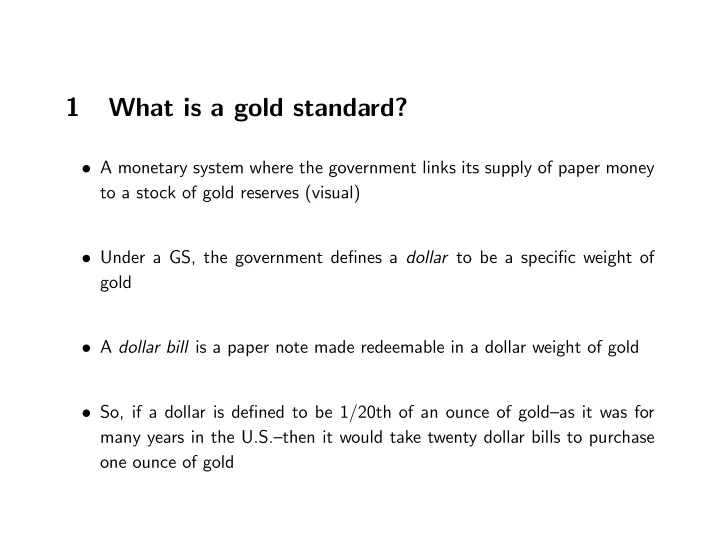

1 What is a gold standard? • A monetary system where the government links its supply of paper money to a stock of gold reserves (visual) • Under a GS, the government de fi nes a dollar to be a speci fi c weight of gold • A dollar bill is a paper note made redeemable in a dollar weight of gold • So, if a dollar is de fi ned to be 1/20th of an ounce of gold—as it was for many years in the U.S.—then it would take twenty dollar bills to purchase one ounce of gold
2 Do we currently operate under a gold stan- dard? • No: the United States, like most countries in the world, currently operates under a fi at money system • Under a fi at money system, a dollar is just an accounting unit — a dollar bill is not redeemable in gold, or any other asset • Paper money is stipulated as legal tender — people can legally pay their debts (including taxes) using paper money
3 What do proponents of a gold standard view as its primary bene fi ts? • Governments cannot fi nance their expenditures by printing money — new expenditure must be fi nanced by borrowing or by raising taxes — in fl ation fi nance is not possible — hence high (and hyper) in fl ation avoided • Also, because gold is costly to mine, the world supply of gold has natural limitations — provides a “nominal anchor” for the price-level (visual)
4 What do opponents of a gold standard view as its primary costs? • A desirable property of any monetary instrument is that it holds its value over short periods of time • A gold standard may deliver a stable price-level in the long-run, but not necessarily in the short-run — the price of gold (and most other assets) can be quite volatile in the short run — just recently, for example, after a run-up in value, the purchasing power of gold dropped by 10% in a single day
— imagine having gone to work for gold one day, and then watching the value of your wages plummet by 10% the next day — imagine purchasing a good for gold one day, only to see the value of your spent gold rise by 10% the next day — it would be frustrating • The demand for money (whatever its form) can fl uctuate a lot in the short run • Under a gold standard, the supply of money remains relatively fi xed — these two facts imply that the purchasing power of monetary gold fl uctuates in the short-run
• This is especially harmful when there are large and persistent unexpected increases in the demand for gold — results in sharp downward movements in the price level (unexpected de fl ation) can lead to depression • Moreover, under a fractional reserve banking system, a gold standard per- mits bank runs — as people rush to redeem their bank money for gold (or dollar bills) — causes an interruption in the payments system • Ine ffi ciency of commodity money
5 Does a gold standard eliminate the possibility of in fl ation? • No: old rushes and “natural” in fl ations • No: Remember: under a gold standard, the government chooses the de fi - nition of a dollar • A government can lower the purchasing power of a dollar bill by making it worth less gold • In the United States prior to 1933, one dollar meant 1/20th of an ounce of gold
• In 1933, President Roosevelt rede fi ned one dollar to mean 1/35th of an ounce of gold — a one dollar bill was now worth less gold (60% less) — the government was able to expand its supply of bills by 60%, without any change in its gold reserves • This act resulted in a signi fi cant decline in the purchasing power of paper money • Moreover, note that there is little to prevent a government from abandon- ing a gold standard — e.g., President Nixon, in 1971
— the link between paper and gold (alluded to in 1st bullet) breaks (visual)
6 What do proponents of a fi at money system view as its primary bene fi ts? • Because money can be created quickly, the supply of money can be ex- panded and contracted to accommodate short-run fl uctuations in money demand — an “elastic” monetary policy can help stabilize the price-level in the short-run — can mitigate the bad consequences of de fl ation • Likewise, it is possible for a central bank to serve as a lender-of-last-resort
— reduces the probabilty of bank runs • Long-run price-level stability can be achieved by creating a politically inde- pendent central bank with a mandate to manage the supply of fi at money over time that targets some measure of price-level stability
7 Conclusion • At the end of the day, what matters for price-level stability is credibility on the part of the monetary authority to manage the money supply in a socially responsible manner — the source of this credibility is not related to the existence of a gold reserve — in fl ation can remain low for long periods of time under a gold standard — but this can also be the case for a fi at money system (e.g., the U.S. since the early 1980s), the EMU since its inception
Recommend
More recommend